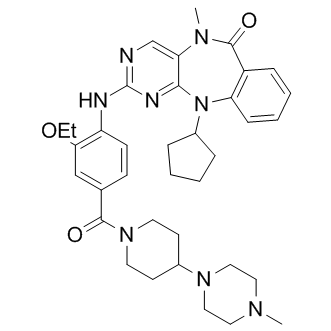| Cas No.: | 1435488-37-1 |
| Chemical Name: | XMD17 109,XMD17109 |
| Synonyms: | XMD17 109,XMD17109 |
| SMILES: | N(C)1C(=O)C2=CC=CC=C2N(C2CCCC2)C2=NC(NC3=CC=C(C(N4CCC(N5CCN(C)CC5)CC4)=O)C=C3OCC)=NC=C12 |
| Formula: | C36H46N8O3 |
| M.Wt: | 638.8 |
| Sotrage: | 2 years -20°C Powder, 2 weeks 4°C in DMSO, 6 months -80°C in DMSO |
| Description: | XMD17-109 is a novel, specific ERK-5 inhibitor, with an IC50 of 162 nM. |
| In Vitro: | XMD17-109 (Compound 26) inhibits ERK5 biochemically with an IC50 of 0.162 ± 0.006 μM, and blocks pidermal growth factor induced ERK5 autophosphorylation with an EC50 of 0.09 ± 0.03 μM in cells. XMD17-109 also inhibits LRRK2[G2019S] with an IC50 of 339 nM[1]. XMD17-109 demonstrats low nanomolar cellular activity judged by the significant dose-dependent reduction of mobility shifted phosphorylated ERK5 bands from sorbitol stimulated cells. XMD17-109 completely inhibits the ERK5-mediated AP1 transcriptional activity at 30 μM and has an EC50 of 4.2 μM[2]. |

 To enhance service speed and avoid tariff delays, we've opened a US warehouse. All US orders ship directly from our US facility.
To enhance service speed and avoid tariff delays, we've opened a US warehouse. All US orders ship directly from our US facility.




















